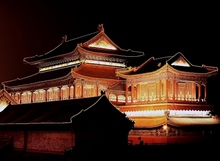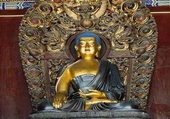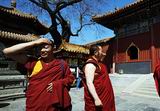
Lama Temple
Category: Cultural Relics Sites
Address : 12 Yonghegong St., Dongcheng District
Open Time : Daily 8:30am - 5:00pm
Reviews: ![]()
Phone : 86-10-64044499
Entrance fee: RMB 25/p.p

Introduction of Lama Temple Beijing
Lama Temple, also known as the Lamasery, lies on the eastern side of Lama Temple Street. It is a renowned lama temple of the Yellow Hat Sect of Lamaism, which is located in the northeast part of city. The Lama Temple is the largest, the most well-protected and typical lamasery in Beijing.
Beijing Lama Temple, an ancient temple recomposed up in Ming and Qing Dynasty for lama from Mongolia and Tibet, which formerly was a Xanadu of Emperor QianLong. Lama Temple features five large halls and five courtyards with beautifully decorative archways, upturned eaves and carved details. It houses a treasury of Buddhist art, including sculptured images of gods, demons and Buddhas, as well as Tibetan-style murals.
The temple combines the architectural styles of Han, Manchu, Mongolian and Tibetan peoples. Rosewood Arhat sculptures, white candlewood Buddha statues and Buddha niche carved with silk wood are three must-see things at the temple.
Lama Temple History
This temple is different from other temples for its uniqueness, in terms of history. It was built in 1694, and was the residence of the Manchu Prince HeZe. In 1723, HeZe succeeded to the throne as Emperor YongZheng. In the third year (1725) of YongZheng's reign, the site was turned into a royal residence, and thus, the green tiles were changed to yellow, for yellow was the imperial color. It was called YongHe Gong (the Palace of Eternal Harmony). The emperor later converted the palace into a lamasery for monks from Mongolia and Tibet, for both Emperor YongZheng and his son, Qianlong, were all believers of Lamaism.
After YongZheng's death in 1735, his coffin was placed in the temple. Emperor QianLong, his successor, upgraded Lama Temple to an imperial palace with its turquoise tiles replaced by yellow tiles (yellow was the imperial color in the Qing Dynasty). During the 9th year of Emperor QianLong's reign (1744), it was converted into a lamasery and became a residence for large numbers of monks from Mongolia and Tibet. This is a kind of friendly policy that the Qing dynasty deals with the relation with Mongolia and Tibet. That is the reason why the Great Wall was not massive constructed during the Qing dynasty.

The temple is listed by the Chinese Government as one of the important historical monuments under special preservation. After the death of his father, Emperor YongZheng moved to the Forbidden City. The compound was closed to ordinary people and was renamed Lama Temple. Green roof tiles were replaced by yellow ones to suit a monarch's home. In 1744 his successor Emperor QianLong converted the palace into a lamasery.
Several renovations have been carried out since 1949. The temple has taken on a new look and was reopened to the public in 1981. It is now not only a functional lama temple, but also a tourist attraction.
Lama Temple Cultural Value
This temple is listed as significant historical site protected by the national government. The Lama Temple preserves over one thousand Buddhist figures and rich classical cultural relics of Buddhism. Besides, it displays a large number of other rare cultural relics, including its three treasures: a 18-metre-high statue of Maitreya (the Smiling Buddha) carved out of a single sandalwood trunk; the miniature ¡°Mountain of Five Hundred Arhats¡± made of gold, silver, copper, iron and tin; and a shrine made of Nanmu, a precious hardwood with golden veins. There were originally four halls for learning, namely, the Hall of Mathematics, the Hall of Explicating the Scriptures, the Hall of Tantra and the Medicine Hall, and lamas studied in these halls with a term usually lasting more than 10 years. It took 30 years for lamas to study Buddhism from enrollment to graduation.
Lama Temple Architecture
The main buildings of YongHe Gong, which are built along a central axis, are: YongHe Gate Hall, YongHe Gong Hall, Yong You Hall, FaLun Hall, WanFuGe Hall and SuiCheng Lou Hall. The side buildings flanking them are: East Side Hall, West Side Hall, Medicine Hall, ShiLun Hall and Esoteric Hall. Before the halls there are three archways and behind them two exhibition rooms of culture relics, the constructional layout of YongHe Gong is splendid and magnificent with characteristics of Manchu, Han, Tibetan and Mongolian cultures.
In every hall, there are many Buddhist statues: pictures of Tangka and culture relics. The three most famous ones are: the Niche of Buddha, which was carved out Nanmu with three layers of filigree; the Five-Hunderd-Arhat mountain carved out of red sandalwood, the 500 Arhats cast in gold, silver, copper, iron and tin; and the Big Buddha-Maitreva Buddha. The statue of the Big Buddha is 18-meter high, the main part of which was carved out of one grand piece of white sandalwood. In 1990 it was recorded in the Guinness Book of World Records.

In the temple, there is a hall called Ten Thousand Buddha Hall. In this hall, a great joss is erected, which is 18 meters high aboveground and 8 meters in depth underground in order to fix the weighty figure. This great figure was built by a whole log, which was endowed by 7th Panchen to Emperor Qianlong. Besides this great artwork, there are other 10 thousand small Buddha¡¯s figures around it, which grants the name, Ten Thousand Buddha Hall, to this building.
In the South of this hall, there is the biggest hall of the Lama Temple. In the middle of this hall, there places the figure of the most significant master of Tibetan Buddhism. And there are two seats in the left and the right of the master¡¯s figure, which are the seats for Panchen Lama and Dalai Lama respectively, who are two masters of the two branches of Lama Buddhism.
WanFuGe (Ten Thousand Happiness Tower) is the largest building in the temple. Tin the tower there is a noted enormous standing figure of Maitreya in sandalwood, which is 26 meters high (18 meters above ground level). It is the largest preserved lamasery in Beijing.
Also, there are some other buildings hosting a lot of figures. As a Chinese temple, there are many censers placed in the courtyard of the temple, with some people kowtowing before the figures and praying for good fortunes and happiness. First built in 1694, the 33 rd year under the reign of Emperor KangXi in the Qing Dynasty, it has already witnessed a history of over 30 years.
Lama Temple Today
Now Lama Temple is a famous tourist destination, and also the biggest Tibetan Buddhist temple of the Yellow School in Beijing. People say that if you pray in this temple, the Buddha will help you to fulfill what your dream of. So lots of Chinese pray for blessings and burn joss sticks there.
That appeals to visitors in the Lama Temple are the 18-metre-high Maitreya statue engraved from a 26-metre-long white sandal-wood log, ¡°the Five hundred Arhats Hill¡± made of gold, silver, copper, iron and tin, and the niche carved out of Nanmu (this kind of Phoebe Nanmu can give off a unusual scent reputed to repel mosquitoes in summer). These three objects are accredited as the three matchless masterpieces in the Lama Temple.
Beijing-Travels.com offers online information on Beijing Lama Temple and private tours as follows, Keep browsing our site for More Attractions information in Beijing China.
Private Tours of Lama Temple

If you could not meet a interesting tours which our predesigned with Lama Temple, we will customize a tour to fit your exact needs.
Special Offer Travels
Beijing-Travels.com is a full service local travel agency offers popular travel packages to Beijing, Great Wall and all over of China. We specialize in "PRIVATE" & "NO-SHOPPING" tours and try to be original, unique and best to satisfy our clients, Let us assist you to experience your own vacations!

